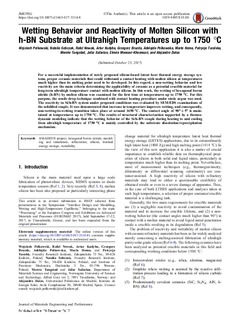| dc.contributor.author | Polkowski, Wojciech | |
| dc.contributor.author | Sobczak, Natalia | |
| dc.contributor.author | Nowak, Rafal | |
| dc.contributor.author | Kudyba, Artur | |
| dc.contributor.author | Bruzda, Grzegorz | |
| dc.contributor.author | Polkowska, Adelajda | |
| dc.contributor.author | Homa, Marta | |
| dc.contributor.author | Turalska, Patrycja | |
| dc.contributor.author | Tangstad, Merete | |
| dc.contributor.author | Safarian, Jafar | |
| dc.contributor.author | Moosavi-Khoonsari, Elmira | |
| dc.contributor.author | Datas, Alejandro | |
| dc.date.accessioned | 2018-03-06T09:36:35Z | |
| dc.date.available | 2018-03-06T09:36:35Z | |
| dc.date.created | 2018-02-05T11:08:53Z | |
| dc.date.issued | 2017 | |
| dc.identifier.citation | Journal of materials engineering and performance. 2017. | nb_NO |
| dc.identifier.issn | 1059-9495 | |
| dc.identifier.uri | http://hdl.handle.net/11250/2488816 | |
| dc.description.abstract | For a successful implementation of newly proposed silicon-based latent heat thermal energy storage systems, proper ceramic materials that could withstand a contact heating with molten silicon at temperatures much higher than its melting point need to be developed. In this regard, a non-wetting behavior and low reactivity are the main criteria determining the applicability of ceramic as a potential crucible material for long-term ultrahigh temperature contact with molten silicon. In this work, the wetting of hexagonal boron nitride (h-BN) by molten silicon was examined for the first time at temperatures up to 1750 °C. For this purpose, the sessile drop technique combined with contact heating procedure under static argon was used. The reactivity in Si/h-BN system under proposed conditions was evaluated by SEM/EDS examinations of the solidified couple. It was demonstrated that increase in temperature improves wetting, and consequently, non-wetting-to-wetting transition takes place at around 1650 °C. The contact angle of 90° ± 5° is maintained at temperatures up to 1750 °C. The results of structural characterization supported by a thermodynamic modeling indicate that the wetting behavior of the Si/h-BN couple during heating to and cooling from ultrahigh temperature of 1750 °C is mainly controlled by the substrate dissolution/reprecipitation mechanism. | nb_NO |
| dc.language.iso | eng | nb_NO |
| dc.publisher | Springer | nb_NO |
| dc.rights | Navngivelse 4.0 Internasjonal | * |
| dc.rights.uri | http://creativecommons.org/licenses/by/4.0/deed.no | * |
| dc.title | Wetting Behavior and Reactivity of Molten Silicon with h-BN Substrate at Ultrahigh Temperatures up to 1750 °C | nb_NO |
| dc.type | Journal article | nb_NO |
| dc.type | Peer reviewed | nb_NO |
| dc.description.version | publishedVersion | nb_NO |
| dc.source.pagenumber | 1-14 | nb_NO |
| dc.source.volume | 27 | nb_NO |
| dc.source.journal | Journal of materials engineering and performance (Print) | nb_NO |
| dc.source.issue | 201 | nb_NO |
| dc.identifier.doi | 10.1007/s11665-017-3114-8 | |
| dc.identifier.cristin | 1561807 | |
| dc.description.localcode | © The Author(s) 2017 Open Access This article is distributed under the terms of the Creative Commons Attribution 4.0 International License (http://creativecommons.org/licenses/by/4.0/), which permits unrestricted use, distribution, and reproduction in any medium, provided you give appropriate credit to the original author(s) and the source, provide a link to the Creative Commons license, and indicate if changes were made. | nb_NO |
| cristin.unitcode | 194,66,35,0 | |
| cristin.unitname | Institutt for materialteknologi | |
| cristin.ispublished | true | |
| cristin.fulltext | original | |
| cristin.qualitycode | 1 | |

